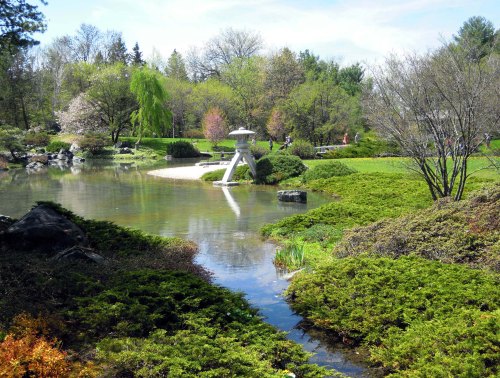
Visited my daughter in Montreal this weekend. Saturday was a lovely day (21-22 Celsius) and we walked around the botanical gardens. It’s such a beautiful place! So, too, is this city.
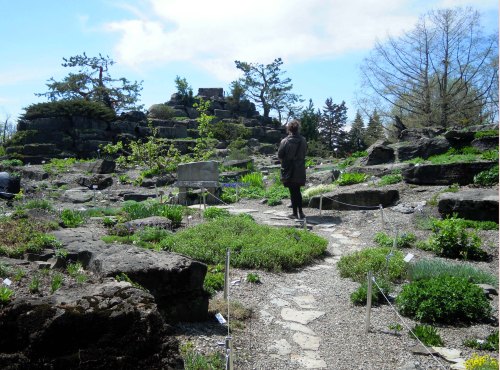

Posted in Miscellaneous, tagged botanical garden, gardens, Montreal, Spring on May 15, 2016| Leave a Comment »

Visited my daughter in Montreal this weekend. Saturday was a lovely day (21-22 Celsius) and we walked around the botanical gardens. It’s such a beautiful place! So, too, is this city.


Posted in Local exploration, tagged gardens, Lake Ontario, Music Garden, parks, public art, Queen's Quay, Toronto, walking, waterfront on June 27, 2015| Leave a Comment »
It’s summertime and I’m near the waterfront. It’s a nice place to walk and offers a diversity of sights, landscapes and activities.
Posted in Local exploration, tagged City Hall, Doors Open, gardens, Nathan Phillips Square, public art, revitalisation, rooftop podium, sculpture on May 30, 2015| Leave a Comment »
 Last weekend was the annual Doors Open event in Toronto. Rather than making a list and heading out to a number of spots I just incorporated a visit to City Hall into my walk.
Last weekend was the annual Doors Open event in Toronto. Rather than making a list and heading out to a number of spots I just incorporated a visit to City Hall into my walk.
I love the Metropolis relief sculpture; people are always getting their photos taken in front of it. I don’t know the people in this photo and they don’t know each other but I liked how the young woman’s hat mimmicks the circular centre of the sculpture and how the man has rested his hand on the nails.
I started my visit wandering around the rooftop podium. I was delighted by the greenspace! The revitalisation project up on the podium and at ground level make it so inviting.
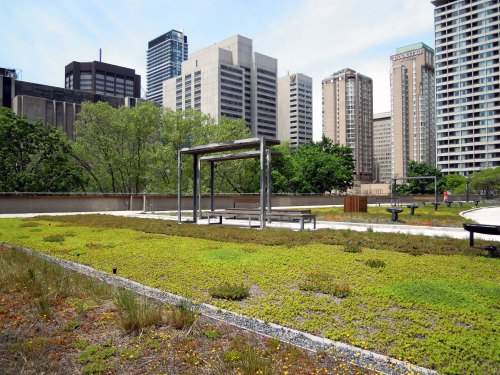 More typically Doors Open oriented, I sat in the council chamber for a while and watched old docs and images and checked out the Hall of Memory and time capsule. Nathan Phillips Square is a popular spot, whether it be a formal event or just hanging around.
More typically Doors Open oriented, I sat in the council chamber for a while and watched old docs and images and checked out the Hall of Memory and time capsule. Nathan Phillips Square is a popular spot, whether it be a formal event or just hanging around.
Posted in Greenspace, Local exploration, tagged gardens, historical site, history, landscape architecture, parks, public space, revitalization, Toronto on May 24, 2015| 2 Comments »
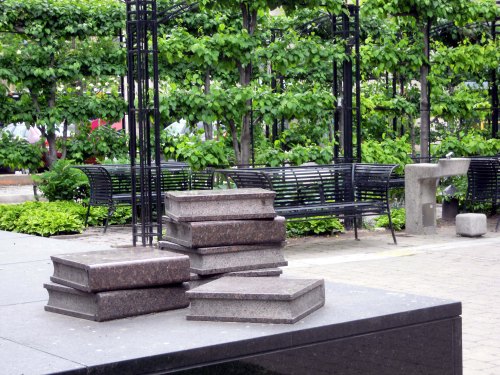 Once used for religious and political gatherings, public floggings and hangings, the square is another story of change and transformation. Situated behind the old Adelaide Street Courthouse, the square is a heritage site that was being used as a parking lot. The revitalized square was designed by Janet Rosenberg & Studio, CS&P Architects, and Susan Schell and built in 1997. It’s a lovely square with heritage plants and water features and I’m looking forward to seeing the garden in bloom.
Once used for religious and political gatherings, public floggings and hangings, the square is another story of change and transformation. Situated behind the old Adelaide Street Courthouse, the square is a heritage site that was being used as a parking lot. The revitalized square was designed by Janet Rosenberg & Studio, CS&P Architects, and Susan Schell and built in 1997. It’s a lovely square with heritage plants and water features and I’m looking forward to seeing the garden in bloom.
The most famous hangings, and the last performed here, were on 12 April 1838: Samuel Lount and Peter Matthews, for their participation in the 1837 Rebellion.
I pulled this quote from the Lost Toronto blog, which references a plaque on Alan Brown’s website but the link is broken. I’m guessing it’s this plaque, located on a building near the square.
Posted in Greenspace, Local exploration, tagged architecture, construction trades, downtown, gardens, landscape architecture, monuments, parks, public art, Toronto on May 23, 2015| Leave a Comment »
This beautiful park sits on a half acre of land in downtown Toronto’s financial district. What a wonderful oasis for nearby workers and those of us who live downtown! There is an indoor garden as well but it’s only open on weekdays.
Cloud Gardens is a result of a partnership between the City of Toronto, Trizec Properties and Markborough Properties. Baird/Sampson Architects, Milus Bollenbourghe Topps Watchorn Landscape Architects, and artist Margaret Priest won the design competition in 1990. The awesome Monument to Construction Workers, built in 1993, is a tribute to the men and women whose labour has built and rebuilt the city.
Posted in Local exploration, tagged butterfly, Echinacea, Edwards Gardens, gardens, groundhog, Toronto Botanical Garden on August 6, 2014| 1 Comment »
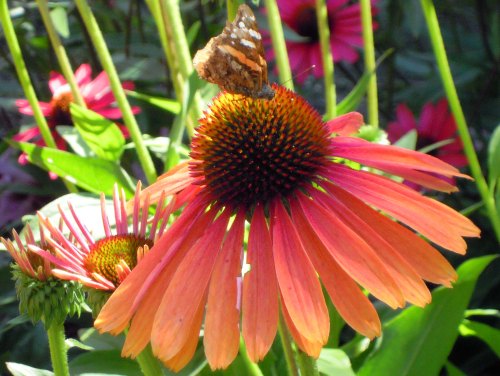 It’s already August! Summer is half way over and I haven’t been out enjoying nature. I’ve been missing the special beauty of a garden so today I visited Edwards Gardens and the Toronto Botanical Garden.
It’s already August! Summer is half way over and I haven’t been out enjoying nature. I’ve been missing the special beauty of a garden so today I visited Edwards Gardens and the Toronto Botanical Garden.
Can you see the butterfly atop the Echinacea flower in the lead photo? Below, I’ve cropped the pic for a closer look. There was a prettier butterfly on a nearby plant but it flew away before I could focus my lens for a closeup.It’s in the next photo but difficult to see.
I love Echinacea plants! The lush colours and the late morning light further enhanced the plant’s ability to fill me with of joy. This alone was worth the three-bus ride, athough, I did spend a few hours meandering around the grounds and then taking in a late lunch at the onsite cafe. The rest of this post is dedicated to photos.
Posted in Greenspace, tagged flora, gardens, Iris, nature on June 17, 2013| Leave a Comment »
Posted in Toastmasters, tagged accessibility, biophilia, gardens, Guelph Enabling Garden, horticultural therapy, public gardens, public space, public speaking on September 19, 2012| Leave a Comment »
We’re back from our summer break and Monday evening I presented project #8 in the Competent Communicator manual – Getting Comfortable With Visual Aids. I selected a subject that would be enriched by a PowerPoint presentation. Here’s the speech without the PP visuals.
The Enabling Garden
It started with a dream. An accessible garden. A garden for people with physical and cognitive challenges. A garden for children and the elderly. A garden for all to enjoy. The dream inspired a community. The city donated parkland and a landscape architect designed it. Volunteers turned it into a physical reality. A horticultural therapist offers active programming and storytellers entertain while visitors sip tea. … This is the Guelph Enabling Garden.
Mr. Toastmaster, fellow members, and welcomed guests, this garden stimulated my heart, mind and senses. I volunteered here in 2010 and this evening I want to share its beauty and purpose with you. The seed was planted in 1999 when it was recognized that there were no public gardens in the city that people with physical and cognitive challenges could access and use. Five years later, in 2004, it came into bloom. Michael Pollan wrote, “A garden should make you feel you’ve entered privileged space … the gardener must put some kind of twist on the existing landscape, turn its prose into something nearer poetry.” The Guelph Enabling Garden has achieved this and more.
There are four key features to an “enabling” garden. It should be accessible, entice the senses, provide reflective areas, and offer hands-on programming. As you can see, the garden path is wide enough for two wheelchairs to comfortably pass by. It contains a wide variety of trees, shrubs, ornamental grasses, herbs and flowering plants and each section has a theme. Benches are located throughout and provide people with a place to sit and think. The section of the garden reserved for active programming contains two standing beds, five raised beds, and several ground beds. Adaptive tools reduce a person’s energy exertion and help keep the body in proper alignment.
Now, if you’re a gardener you already know there’s a therapeutic element to gardening. The Canadian Horticulture Therapy Association defines horticultural therapy as, “the use of plants and the natural world to improve the social, spiritual, physical and emotional wellbeing of individuals who participate in it.” How are these benefits manifested? Participants meet new people and improve teamwork and relationship skills. People connect with nature, the community and life. It impacts others in the broader community. It fosters awareness of natural forces and rhythms, and of interdependence. Gardening is a meaningful and purposeful activity. It’s real and it motivates and inspires. It increases strength and range of motion, makes use of fine and gross motor skills and eye/hand coordination. It enhances self-esteem and creative expression. It provides inner peace. People of all ages and abilities can benefit from HT.
The mural you see in the slide graces the side of the garden shed. People, art, nature and utility comfortably coexist here. It seems to me that a garden is a buffer zone between the urban and the wild. A sanctuary. I felt closely connected to nature while volunteering at the Enabling Garden. You can sense the connection in this child. You experience it passively, too, just by being there. One day, I was chatting with a senior from Fergus, a nearby town, and he told me he visits every week because his dog loves being here. Another visitor, a young boy, approached the garden’s spiral and exclaimed, “Mommy, it’s a plant paradise!” The sociobiologist Edward O. Wilson hypothesized that humans have an innate emotional response to nature and all living things. He called this biophilia.
I encourage you to spend time in nature, whether hiking in the woods, strolling along a tree-lined path, visiting a public garden, or puttering in your own yard with raised beds and special tools, if needed. It’s healing and restorative. The echinaceas in this slide are located in the woodland section. It was my favourite part of the garden. Their beauty stirred me and I felt aware and at peace. The Enabling Garden is a gift for its many visitors, program participants and volunteers. An accessible garden where prose has become poetry. “How fair is a garden amid the trials and passions of existence.” (Benjamin Disraeli) … Mr. Toastmaster.
Posted in Local exploration, tagged architecture, art, culture, Doors Open, festivals, gardens, history, Ottawa, re-adapted buildings on June 5, 2011| Leave a Comment »
June 4th & 5th marked the 10th annual Doors Open Ottawa weekend. Of the 111 participating sites I made it out to about 10. There were a few others I would have liked to visit but late starts, bus schedules, distances, walking and just enjoying the day came into play. Weatherwise it was a perfect weekend.
The Central Chambers building is one of my favourites. It looks more like a contemporary revival rather than a Victorian-era building. It was the first building in Ottawa to have an electric elevator and is thought to be the first in North America with bay windows.
The grounds at Rideau Hall are spectacular. I wonder if the Governor Generals ever have the time or inclination to enjoy this beautiful oasis. As for the residence, the tent room, a former indoor tennis court, is kinda quirky and gay, but, what I most enjoyed were the paintings representing early immigration to Canada.
And just a couple blocks away, Gordon Harrison’s cottage studio was a lovely spot with live music, wine and, of course, quite awesome art works.

The Lester B. Pearson building, home to the Department of Foreign Affairs and International Trade, had a great collection of models of Canadian embassies in other parts of the world, as well as staff, literature and video on DFAIT’s roles.
Maplelawn is a beautiful Georgian-style home and garden. The historical building has been re-adapted and currently functions as a restaurant. The walled gardens date back to 1833 and served as a vegetable garden. It holds a lovely collection of perennials and the grounds are maintained by volunteers.
The Enriched Bread Artists and Gladstone Clayworks Coop are housed in another re-adapted building. The 1924 industrial building was the site of the Standard Bread Factory. I had meant to stop in at the nearby Traffic Operations but with thoughts of coffee in my head it slipped my mind.
I had started Sunday at Fairfields, a 19th century Gothic Revival farmhouse. It was home to five generations of the Bell family and also functioned as a tavern and hotel. In addition to farming, various members of the family were active in law and politics. A number of period artifacts were on display in the garden and, even with the interpreter’s clues, I was not able to guess what most of them had been used for.
Posted in Greenspace, tagged Crab apple, Dow's Lake, gardens, Hawthorn, nature, Ottawa, Spring, trees on May 19, 2011| Leave a Comment »
Prince of Wales is one of the Ottawa streets that I quite like. The trees are in bloom and the area is infused with lovely spring growth and colour. It’s major downfall is the constant procession of traffic! The Canadian Agriculture Museum, Ornamental Gardens and Arboretum, which are part of the Central Experimental Farm, and the Fletcher Wildlife Centre are situated in the Dow’s Lake area. I wandered around this area today for the first time… and along the the Rideau Canal path.




